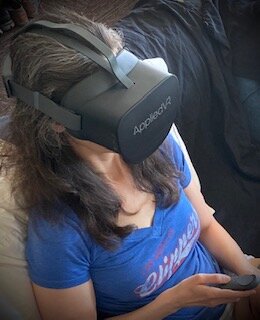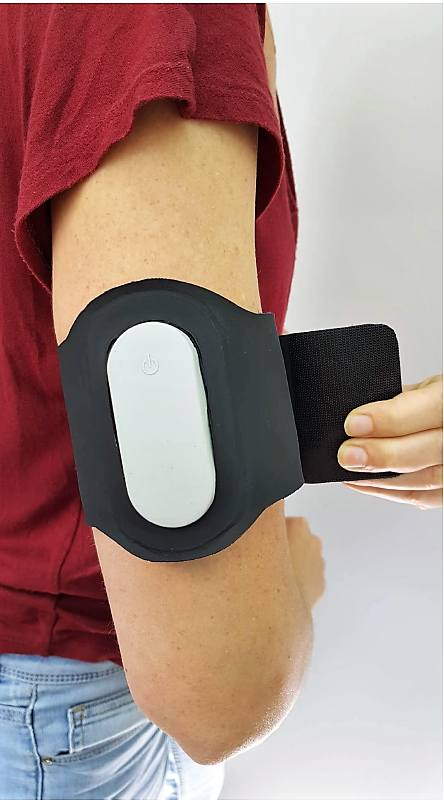How Ketamine Infusions Helped Me
/By Madora Pennington, PNN Columnist
Berkley Jones is a tough lady. Already a nurse, she joined the U.S. Air Force in her late 30’s, even though she had never run a mile in her life. She worked hard, made it through boot camp and went directly into officer training.
Her life changed after an allergic reaction so severe it required hospitalization. Berkeley never felt the same. Aching and tired, an immunologist diagnosed her with fibromyalgia. Berkley powered on.
Then, during a training exercise that simulated medical scenarios that might happen from a nuclear attack, she severely injured her arm. She awoke after surgery with her arm swollen to five times its normal size and feeling like it was on fire. The pain was unbearable. This was the beginning of her life with Complex Regional Pain Syndrome (CRPS).
For the next six years, her life was consumed by pain. Berkley tried everything doctors recommended. Nothing eased her agony. Wheelchair-bound, she left the military. “I basically stayed in bed most of the time. I was very depressed and in pain,” she recalls.
Berkley heard of ketamine from a friend, looked around and was accepted into a ketamine for CRPS study. She checked into the hospital for 5 days of intravenous ketamine infusions. The results were life-changing.
“By the end of the study I was able to use a cane instead of a wheelchair. I was able to get out of bed and my pain was down to livable levels,” she says.
Berkley went on to write a book, “Ketamine Infusions: A Patient's Guide” and organized Facebook groups to educate patients and doctors about ketamine.
From Anesthetic to Party Drug
Ketamine has become a trendy new treatment for pain and depression, but it’s actually been around for decades. Chemists first discovered ketamine in 1956. By the 1960s, it was in widespread use as an anesthetic, from veterinary offices to battlefields. Ketamine is only approved by the FDA for depression, anesthesia and post-surgical acute pain — which makes its use as a treatment for chronic pain off-label.
Ketamine is not an opioid and does not suppress breathing, making it relatively safe to use. But it does produce an unusual state of dissociation. Patients appear awake, but are often unable to respond to sensory input.
Because the experience is similar to psychosis (delirium, delusions or hallucinations), ketamine also became an underground party drug.
More and more uses are being found for this very unique compound. Ketamine triggers production of glutamate in the brain, which makes connections in the brain regrow. Cognition and mood improve as the brain gets a reboot from the damage of long-term stress that leads to excessive negative thoughts and feelings.
For chronic pain sufferers, ketamine temporarily reverses “central sensitization,” where the brain and spinal nerves receive so much pain input, they go off kilter and the slightest touch becomes painful. This can get so bad that some chronic pain sufferers come to find odors, light and sound extremely painful. Brain fog, poor memory, poor concentration and intense anxiety also happen as part of this cycle of pain overload.
Low Dose Ketamine
While hospitals treat chronic pain patients with multi-day, high dose infusions of ketamine, outpatient clinics have sprouted up around the country, offering less intense treatment with lower doses.
I began seeing anesthesiologist Dr. David Mahjoubi, of Ketamine Healing Clinic of Los Angeles this year. My foot was very swollen, weeks after surgery. I was looking for a way to reduce the inflammation without stopping the healing process, as ice, NSAIDs and steroids tend to do. I was fortunate to get an appointment, as some LA clinics have a two-year waiting list for infusions.
Dr. Mahjoubi explained ketamine to me this way: “It increases connections between brain cells, thus ‘rewiring’ brain circuitry. Ketamine also blocks pain receptors called NMDA. This is the mechanism for blocking pain. For persons with PTSD, the trauma seems to get processed in a mild, non-troubling way. Ketamine separates one from their anxiety or depression. A ‘release’ is how patients commonly describe it.”
In Dr. Mahjoubi’s experience, ketamine infusions multiple days in a row can be a bit tough. Spreading them out over several weeks can still get good results. It depends on the individual and the amount of relief they receive.
I was afraid to try ketamine, but agreed to a low dose, one-hour infusion. The swelling in my foot dramatically improved. Chronic, low-grade discomfort along my spine also disappeared. I felt emotional relief from past trauma, from pain and other life experiences.
I continued with one low dose infusion every few weeks. I don’t like the experience of the infusion, but it has been well worth it.
I was relieved of minor aches and able to increase my exercise. I did not feel terror when pain kicked in. Sometimes the pain just floated away.
I no longer feared my physical therapist touching my neck, and noticed I was enjoying it. My mood improved and I felt smarter. My ability to concentrate and remember improved.
My neighbor’s annoying dog sounded like he was a few houses away, not barking inside my head.
MADORA PENNINGTON GETTING AN INFUSION
I felt more connected with others and more accepting of life — less anxious, less terrorized, less inclined to ruminate after every infusion.
I do tend to have fatigue or short periods of intense emotion, which is not unusual. For me, this is just hard work on my health, like going to physical therapy.
Treatment for Depression
Tara Dillon, a nurse practitioner, opened Happier You, a ketamine clinic in Columbus, Ohio, after infusions helped her 20-year struggle with depression. She’s had good results treating patients with psychiatric complaints, such as depression, anxiety, and bipolar disorder.
“It's well-known that pain and psychiatric diagnoses, particularly depression, tend to coincide. Patients often report physical improvements such as relief from IBS, improved sleep, or increased energy after ketamine therapy,” she explained. “While everyone is nervous for the first infusion, since they don't know what to expect, most patients end up enjoying the experience.”
Tara usually starts with a low dose of 0.5mg ketamine over 40 minutes, but will titrate up depending on how a patient responds. The most common side effect is mild nausea. Ketamine is not a cure for chronic pain, and it takes time to have an effect.
“For me, ketamine never kicks in immediately. Some people get relief in the first week. It takes at least two weeks and for some, like me, it can take 3 to 4 weeks,” says Berkley Jones. “Once it does kick in, I usually have low pain levels for about 6 to 8 weeks and then they start to climb again. Sometimes overnight the pain comes back excruciating, but the majority of the time it’s a slow increase in my pain back to where it was.”
Unfortunately, insurance won’t always cover ketamine. While the drug itself is cheap, the infusions are expensive because patients must be monitored. That is a real shame, as high-impact chronic pain affects 20 million adults in the United States. This is terrible burden not only to the sufferer, but to their loved ones and the community. Perhaps this will change if and when ketamine is FDA approved as a treatment for chronic pain.
Madora Pennington lives with Ehlers-Danlos Syndrome. Sher writes about EDS and life after disability at LessFlexible.com. Her work has also been featured in the Los Angeles Times.








